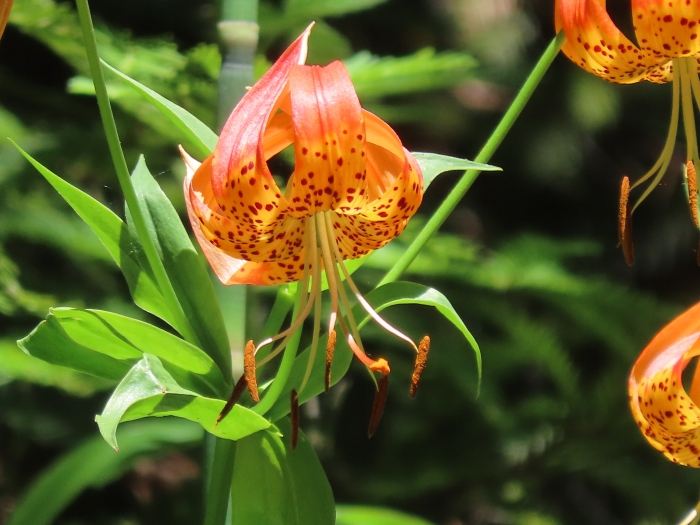Leopard Lily
(Lilium pardalinum)
Leopard Lily (Lilium pardalinum)
/
/

icosahedron
CC BY 4.0
Image By:
icosahedron
Recorded By:
Copyright:
CC BY 4.0
Copyright Notice:
Photo by: icosahedron | License Type: CC BY 4.0 | License URL: http://creativecommons.org/licenses/by/4.0/ | Rights Holder: icosahedron | Publisher: iNaturalist | Date Created: 2019-07-02T13:17:24-07:00 |
























































Estimated Native Range
Summary
Lilium pardalinum, commonly known as Leopard Lily, is a deciduous perennial herb that is native to riparian zones, wet meadows, and open woodlands of California and Oregon. It can reach a typical height of about 2 meters (6.6 ft), with the most vigorous plants growing up to 2.5 meters (8.2 ft). The plant forms clumps with small bulbs clustered on a rhizomatous stock. The striking flowers are Turk’s-cap shaped, red-orange with numerous brown spots, and bloom in July, adding a vibrant splash of color to the garden. The Leopard Lily is particularly noted for its showy flowers and ability to attract hummingbirds.
In cultivation, the Leopard Lily is valued for its ornamental qualities, including its tall, stately form and the bright, spotted flowers that provide a dramatic display in midsummer. It is a popular choice for native plant gardens, wildlife gardens, and as a height accent in flower borders. It is also suitable for cut flower arrangements and has received the Royal Horticultural Society’s Award of Garden Merit. This lily thrives in full sun to part shade and requires medium amounts of water and well-drained soil. It is relatively easy to maintain but may require staking in windy areas. While generally disease-resistant, it can be susceptible to lily beetle infestations.CC BY-SA 4.0
In cultivation, the Leopard Lily is valued for its ornamental qualities, including its tall, stately form and the bright, spotted flowers that provide a dramatic display in midsummer. It is a popular choice for native plant gardens, wildlife gardens, and as a height accent in flower borders. It is also suitable for cut flower arrangements and has received the Royal Horticultural Society’s Award of Garden Merit. This lily thrives in full sun to part shade and requires medium amounts of water and well-drained soil. It is relatively easy to maintain but may require staking in windy areas. While generally disease-resistant, it can be susceptible to lily beetle infestations.CC BY-SA 4.0
Plant Description
- Plant Type: Herb, Bulb
- Height: 3-7 feet
- Width: 0.5-1 feet
- Growth Rate: Moderate
- Flower Color: Brown, Orange, Red
- Flowering Season: Summer, Fall
- Leaf Retention: Deciduous
Growth Requirements
- Sun: Full Sun, Part Shade
- Water: Medium, High
- Drainage: Medium
Common Uses
Bee Garden, Bird Garden, Border Plant, Butterfly Garden, Edible*Disclaimer: Easyscape's listed plant edibility is for informational use. Always verify the safety and proper identification of any plant before consumption., Fragrant, Hummingbird Garden, Low Maintenance, Showy Flowers, Water Garden
Natural Habitat
Native to riparian zones, wet meadows, and open woodlands of California and Oregon
Other Names
Common Names: Panther Lily , Panterlilja
Scientific Names: Lilium pardalinum , Lilium canadense var. pardalinum
GBIF Accepted Name: Lilium pardalinum Kellogg